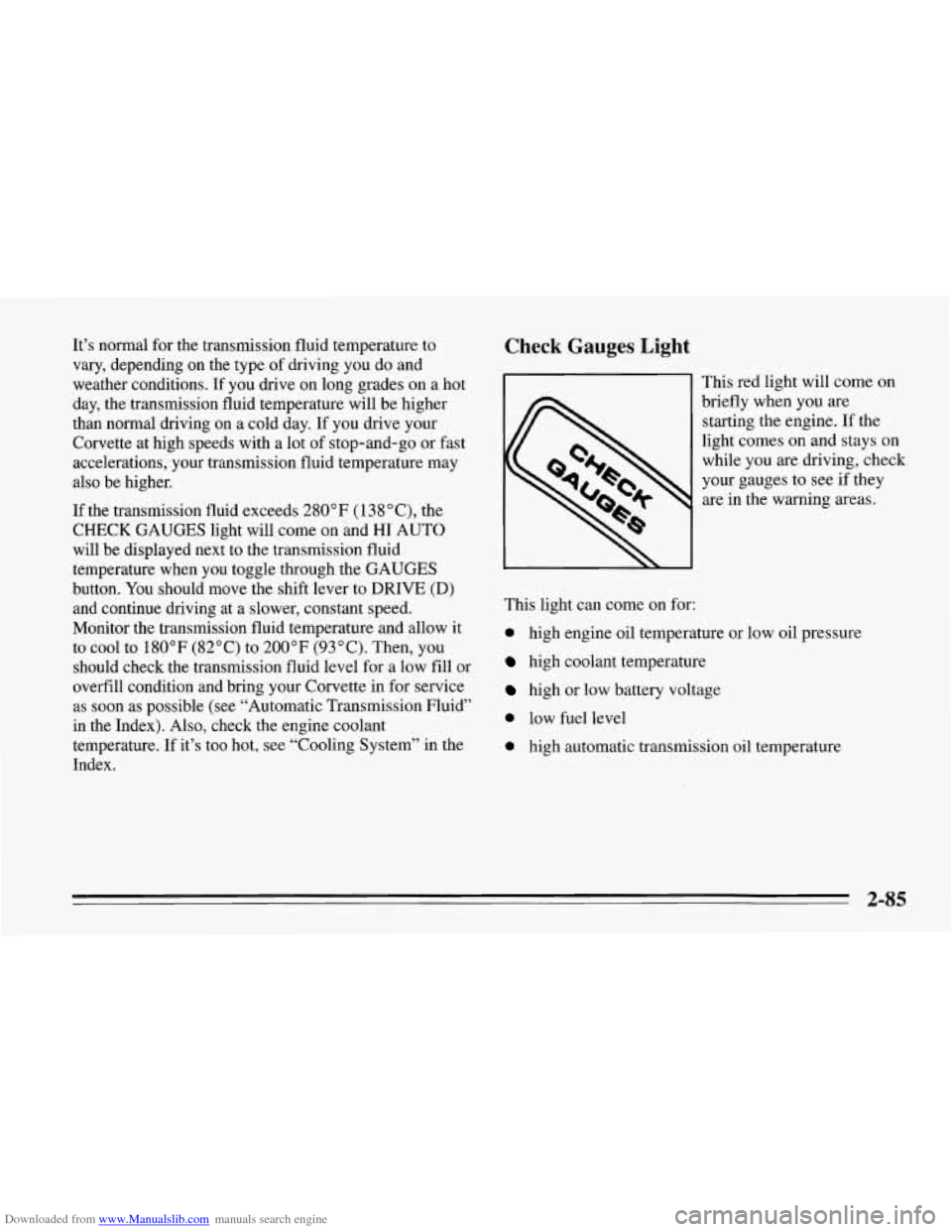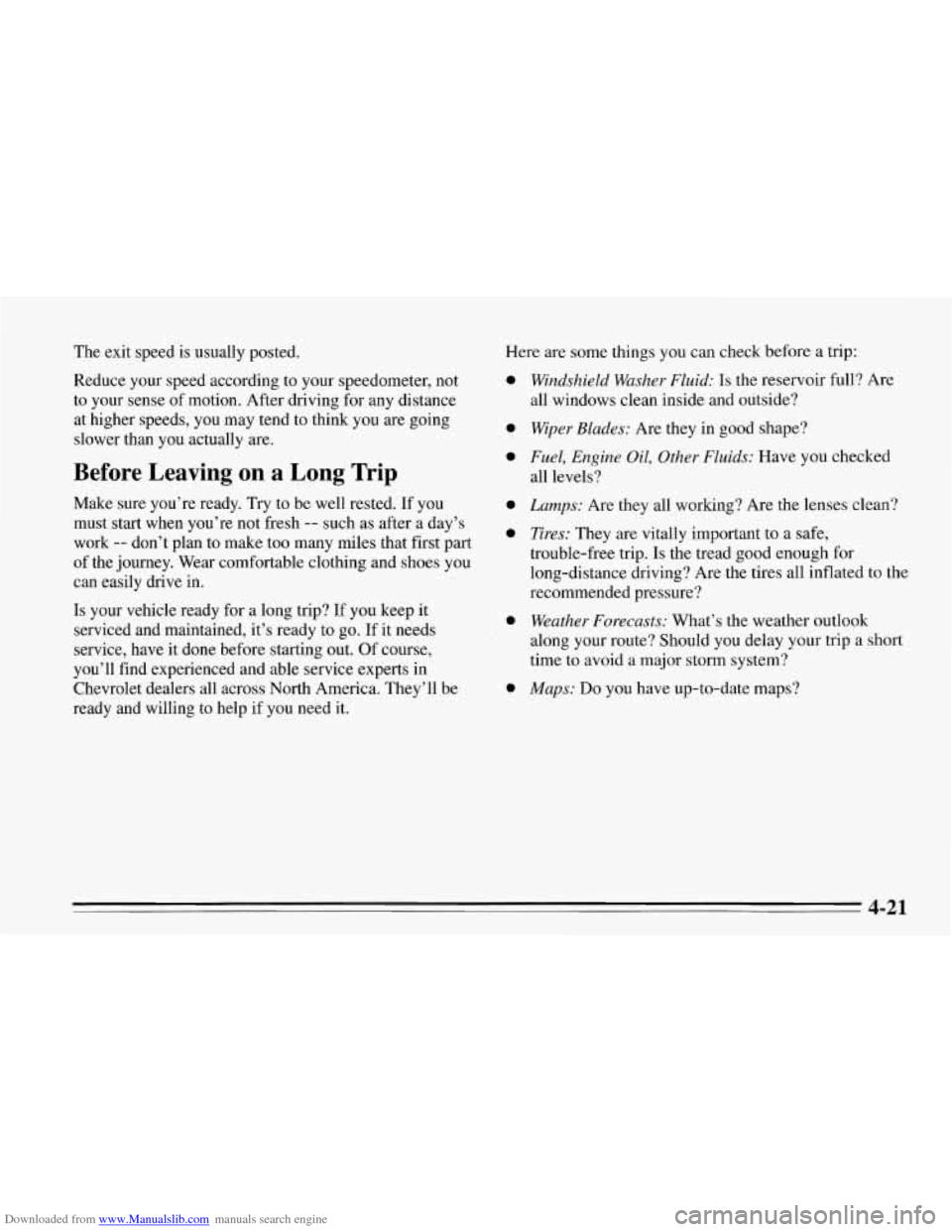Page 65 of 386
Downloaded from www.Manualslib.com manuals search engine Racing or Other Competitive Driving
See your Warranty Book before using your Corvette for
racing
or other competitive driving.
NOTICE:
If you use your Corvette for racing or other
competitive driving, your engine may use more oil than
it would with normal use. Low oil levels
can damage the engine. Be sure to check the oil
level often during racing or other competitive
driving and keep the level at or near the upper
mark on the engine oil dipstick. You may need to
add oil. See “Engine Oil” in the Index.
J
Driving Through Deep Standing
Water
NOTICE:
If you drive too quickly through deep puddles or
standing water, water can come in through your
engine’s air intake and badly damage your
engine. Never drive through water that is slightly
lower than the underbody of your vehicle.
If you
can’t avoid deep puddles or standing water, drive
through them very slowly.
2-22
Page 124 of 386
Downloaded from www.Manualslib.com manuals search engine NOTICE:
Damage to your engine from neglected oil
problems can be costly and
is not covered by your
warranty.
Engine Oil Temperature Gauge
LT1 LT5
This gauge shows your engine oil temperature. Oil
temperature may vary with the type
of driving you do
and weather conditions. If your gauge pointer moves
close to or into the shaded area and stays there, your oil
temperature is too high. Check the engine coolant
temperature and engine oil level. If your engine is too
hot, see “Engine Overheating” in the Index. Your
vehicle may need service; see your dealer.
2-81
Page 128 of 386

Downloaded from www.Manualslib.com manuals search engine It’s normal for the transmission fluid temperature to
vary, depending on the type of driving you do and
weather conditions. If you drive on long grades on a hot
day, the transmission fluid temperature will be higher
than normal driving on a cold day. If you drive your
Corvette at high speeds with a lot of stop-and-go or fast
accelerations, your transmission fluid temperature may
also be higher.
If the transmission fluid exceeds
280°F (138 “C), the
CHECK GAUGES light will come on and HI
AUTO
will be displayed next to the transmission fluid
temperature when you toggle through the GAUGES
button. You should move the shift lever to DRIVE (D)
and continue driving at a slower, constant speed.
Monitor the transmission fluid temperature and allow
it
to cool to 180°F (82°C) to 200°F (93°C). Then, you
should check the transmission fluid level for a low fill or
overfill condition and bring your Corvette in for service
as soon as possible (see “Automatic Transmission Fluid”
in the Index). Also, check the engine coolant
temperature. If it’s too hot, see “Cooling System” in the
Index.
Check Gauges Light
This red light will come on
briefly when you are
starting the engine. If the
light comes on and stays on
while
you are driving, check
your gauges to see if they
are
in the warning areas.
This light can come
on for:
0 high engine oil temperature or low oil pressure
high coolant temperature
high or low battery voltage
0 low fuel level
0 high automatic transmission oil temperature
2-85
Page 129 of 386
Downloaded from www.Manualslib.com manuals search engine Low Oil Light
LOW
OIL
T
This amber light should
come on while you are
starting your engine.
If the
light doesn’t come on, have
it repaired.
If the light
comes on while starting
your engine and stays on,
your engine oil level may be
too low. You may need to
add oil. See “Engine Oil” in
the Index.
Engine Oil Life Monitor
The amber CHANGE OIL
light comes on for a few
seconds when you turn the
ignition
on. It will come on
and stay on when it’s time
to change your oil.
The monitor uses oil temperature and engine revolutions
to decide when the oil is nearly worn out. The light is
only a reminder, though.
You should change your oil at
the intervals recommended in your Maintenance
Schedule, even if the
CHANGE OIL light hasn’t come
on.
2-86
Page 184 of 386

Downloaded from www.Manualslib.com manuals search engine The exit speed is usually posted.
Reduce your speed according to your speedometer, not
to your sense of motion. After driving for any distance
at higher speeds, you may tend to think
you are going
slower than you actually are.
Before Leaving on a Long Trip
Make sure you’re ready. Try to be well rested. If you
must start when you’re not fresh
-- such as after a day’s
work
-- don’t plan to make too many miles that first part
of the journey. Wear comfortable clothing and shoes you
can easily drive in.
Is your vehicle ready for a long trip?
If you keep it
serviced and maintained, it’s ready to
go. If it needs
service, have it done before starting out. Of course,
you’ll find experienced and able service experts in
Chevrolet dealers all across North America. They’ll be
ready and willing to help if you need it. Here
are some things you can check before a trip:
0
0
0
0
0
0
0
Windshield Washer Fluid: Is the reservoir full? Are
all windows clean inside and outside?
Wiper Blades: Are they in good shape?
Fuel, Engine Oil, Other Fluids: Have you checked
all levels?
Lamps: Are they all working? Are the lenses clean?
Tires: They are vitally important to a safe,
trouble-free trip. Is the tread good enough for
long-distance driving? Are the tires all inflated to the
recommended pressure?
Weather Forecasts: What’s the weather outlook
along your route? Should you delay your trip a short
time to avoid
a major storm system?
Maps: Do you have up-to-date maps?
4-21
Page 247 of 386
Downloaded from www.Manualslib.com manuals search engine Engine Oil
If you have the LT1 engine, it’s a good idea to check
your engine oil level every time you get fuel. In order to
get
an accurate reading, the oil must be warm and the
vehicle must be on level ground.
Turn
off the engine and give the oil a few minutes to
drain back into the oil pan.
If you don’t, the oil dipstick
might not show the actual level. If
you have the LT5
~ engine,
the best time to ~ check your engine oil
is when the engine is cold.
If
you run the engine, the engine oil won’t drain back
into the pan fast enough. Give the oil two hours to drain
back into the oil pan.
If you don’t, the oil dipstick might
not show the actual level.
6-12
Page 248 of 386
Downloaded from www.Manualslib.com manuals search engine - e... . .... *.*.*.
To Check Engine Oil
Pull out the dipstick and clean it with a paper towel or a
cloth, then push it back in all the way. Remove it again,
keeping the tip down.
LTl Engine
When to Add Oil
If the oil is at or below the ADD mark you’ll need to
add some oil.
But you must use the right kind. This part
explains what kind of oil to use.
For crankcase capacity,
see “Capacities and Specifications” in the Index.
NOTICE:
Don’t add too much oil. If your engine has so
much oil that the oil level gets above the upper
mark that shows the proper operating range,
your engine could be damaged.
6-13
Page 249 of 386
Downloaded from www.Manualslib.com manuals search engine LT5 Engine
Just fill it enough
to put the level somewhere in the
proper operating range. Push the
dipstick all the way back in when
you’re through. What Kind of Oil to Use
Look for two things:
0 GM4718M
The Corvette engine requires a special oil meeting
GM Standard GM4718M. Oils meeting this Standard
may be identified as synthetic. However, not all
synthetic oils will meet this GM Standard. You
should look for and use only an oil that meets GM
Standard GM47 1 8M.
NOTICE:
If you use oils that don’t have the GM4718M
Standard designation, you can cause engine
damage not covered by your warranty.
6-14